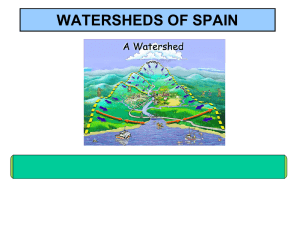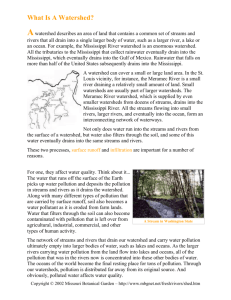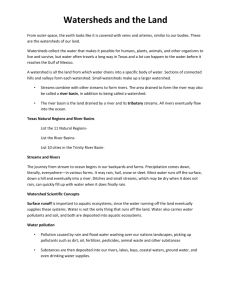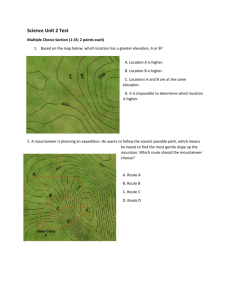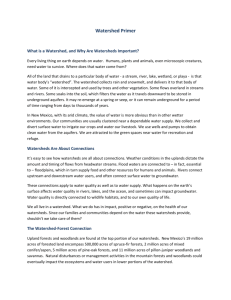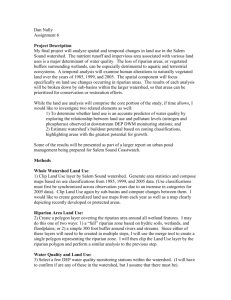River flow: where does the water go?
advertisement
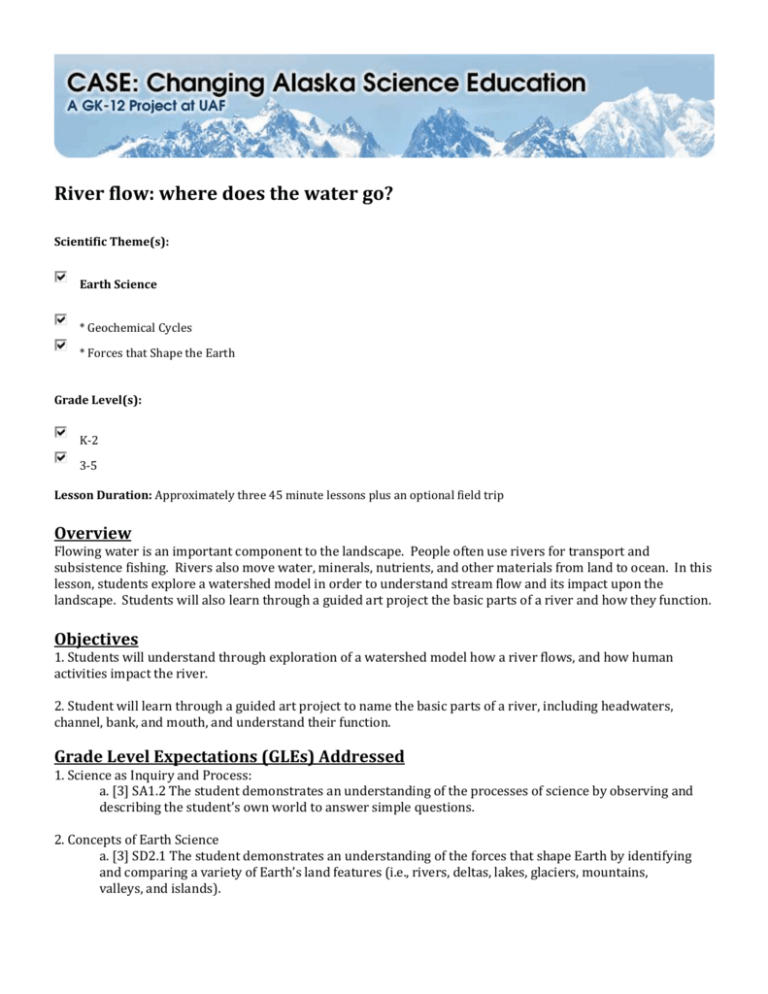
River flow: where does the water go? Scientific Theme(s): Earth Science * Geochemical Cycles * Forces that Shape the Earth Grade Level(s): K-2 3-5 Lesson Duration: Approximately three 45 minute lessons plus an optional field trip Overview Flowing water is an important component to the landscape. People often use rivers for transport and subsistence fishing. Rivers also move water, minerals, nutrients, and other materials from land to ocean. In this lesson, students explore a watershed model in order to understand stream flow and its impact upon the landscape. Students will also learn through a guided art project the basic parts of a river and how they function. Objectives 1. Students will understand through exploration of a watershed model how a river flows, and how human activities impact the river. 2. Student will learn through a guided art project to name the basic parts of a river, including headwaters, channel, bank, and mouth, and understand their function. Grade Level Expectations (GLEs) Addressed 1. Science as Inquiry and Process: a. [3] SA1.2 The student demonstrates an understanding of the processes of science by observing and describing the student’s own world to answer simple questions. 2. Concepts of Earth Science a. [3] SD2.1 The student demonstrates an understanding of the forces that shape Earth by identifying and comparing a variety of Earth’s land features (i.e., rivers, deltas, lakes, glaciers, mountains, valleys, and islands). Required Background 1. Know what a watershed is and how it functions. See http://water.epa.gov/type/watersheds/whatis.cfm for a definition. 2. Know how to use the Enviroscape watershed model. A demonstration of a similar model may be found on Estuary Live TV, 130-Watershed Demo, http://www.youtube.com/watch?v=1cEPz5qNLyg 3. Be familiar with the basic parts of a river, and how those parts function. The American Rivers website has this information: http://www.americanrivers.org/rivers/about/what-parts-make-up-a-river.html Vocabulary 1. Headwaters 2. Riverbank 3. River channel 4. River mouth 5. Watershed 6. Pollution 7. Riparian plants Materials Part 1 1. Butcher paper 2. Thick-tipped markers of various colors 3. Visual aids i.e. a slideshow or picture book on watersheds and rivers to introduce the material Part 2 1. Fairbanks Soil and Water Conservation District’s Enviroscape watershed model (call 479-1213 x105 to enquire and reserve) Part 3 1. River template, 1 per student (K-2) 2. Printed vocabulary word bank, 1 per student (K-2) 3. Clip art of animals, plants, and buildings found by rivers, 1 sheet per student 4. Pencils 5. Black markers 6. Crayons 7. Scissors 8. Glue stick Activity Preparation and Procedure Part I: Introduction to watersheds and rivers (45 min.) 1. Begin the discussion of watersheds with a story-telling session: invite students to share their knowledge of and experiences with rivers. Create a KWL chart and/or word map based on student input. 2. Introduce the word “watershed” and define it for the students. 3. Illustrate the concept of a watershed and associated watercourses via a visual aid such as a slideshow or picture book. Part II: Watershed model demonstration (45 min.) 1. Set up the model base in an appropriate location for the age group. For K-2 students, the model is best placed on the floor and kept hidden until use to avoid distractions. 2. Briefly remind students of the concepts introduced and discussed during the previous lesson. 3. Show students the model and start to build. Narrate the process. For this first phase, leave off the trees. 4. Make it rain! Watch as the pollution runs off into the river. 5. Look at the water in the “lake.” The students can see the brown color is not healthy for the fish and birds living in the lake. 6. Clean off the model and dump out the lake. 7. Rebuild the model, this time adding “riparian plants” along the river. Use the trees inserted into the sponges provided in the kit. 8. Make it rain again and have students observe the pollution. Where does it go? Does the pollution end up in the river? No! The soils and plants store the pollution. The riparian plants work like a filter. 9. Discuss why we should leave riparian zones intact along rivers. Part III: Riverscape guided art project (45 min.) 1. For K-2 students, provide a basic river drawing (curved lines) on a large piece of white construction paper. Older students can draw their own river outline. 2. Also provide 1 sheet of clip art showing typical plants, animals, buildings, and human activities along waterways (not provided) and 1 vocabulary word bank (provided at the end of this lesson plan). 3. Model the activity using a document camera. Start by asking students to trace or draw their river using black crayon or marker. 4. Color, cut, and paste clip art of plants and animals on one side of the river. 5. Color, cut, and paste clip art of buildings and human activities on the other side of the river. 6. Identify the parts of the river. Use the word bank to cut and paste labels in appropriate locations. Discuss the function of each part before students place the labels. 7. Finish by asking students to name their river. Assessment 1. Ask students to fill in blank labels on a watershed illustration. For K-2 students, include a word bank. 2. Older students may be given a watershed scenario, such as point pollution from mining activities or stream bank management for salmon habitat, and provide a written response that shows understanding of how different part of the system function and work together, as well as ideas for management and clean-up. Complementary Activities and Extension Ideas 1. Take a fieldtrip to the Chena River to observe parts of the river and its watershed. a. Have students work with a partner and count (tally) the number of houses and/or buildings they find as they walk to/around the river. b. Look for and tally storm drains. Discuss that water flowing into storm drains bypasses the riparian plants. Most storm drains in Fairbanks that are close to a river have a fish painted on them, which indicates the water drains directly into the river. c. As students walk along the river, ask them to identify natural parts of river systems (riparian plants, river channels, river banks). There may be some areas where you can point out erosion. d. Are there industrial or recreational areas surrounding the river? How will these impact the river? e. Do you see people using the river? Describe these activities. 2. Choose an endangered river system to study in depth, such as the Potomac. Formulate a recovery plan as a class or in small groups. See http://www.americanrivers.org/endangered-rivers/ for more information. References American Rivers websites http://www.americanrivers.org/rivers/about/what-parts-make-up-a-river.html http://www.americanrivers.org/endangered-rivers/ Environmental Protection Agency (EPA). (2012, March 6). What is a watershed? Retrieved from http://water.epa.gov/type/watersheds/whatis.cfm Estuary Live TV, 130-Watershed Demo, retrieved from: http://www.youtube.com/watch?v=1cEPz5qNLyg Fairbanks Soil and Water Conservation District http://www.fairbankssoilwater.org/education_Educators_Page.html Vocabulary Word Bank Headwaters Riverbank River channel River mouth Watershed Riparian plants Headwaters Riverbank River channel River mouth Watershed Riparian plants Headwaters Riverbank River channel River mouth Watershed Riparian plants

